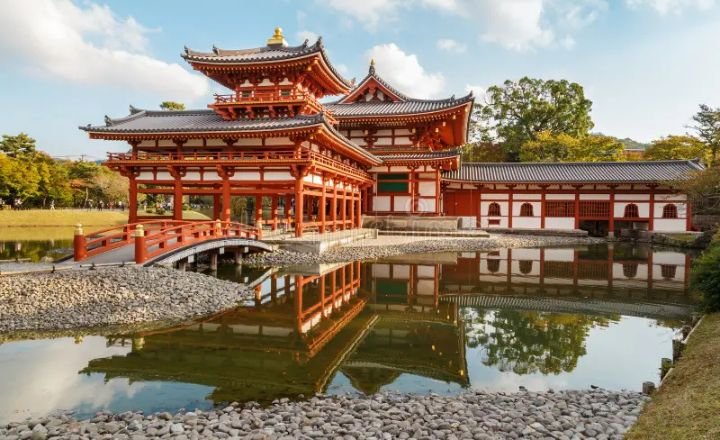Nestled amid the lush greenery and serene landscapes of Oahu, Hawaii, lies a hidden gem that transports visitors to a realm of peace and reflection Oahu’s Japanese Byodo-In Temple. As you step through its ornate gates, the gentle sound of flowing water and the rustle of palm leaves create an atmosphere reminiscent of ancient Japan. This magnificent replica of the original byodo-in temple in Uji, Japan, was built to commemorate the 100th anniversary of Japanese immigrants arriving in Hawaii.
The Byodo-In Temple is not merely a picturesque site; it encapsulates centuries of cultural significance and reverence for peace.
Ready to take a mini vacation to Japan without leaving Hawaii?
The byodo-in temple, nestled at the foot of the Ko’olau Mountains, offers an enchanting escape that transcends mere travel. This replica of the original 950-year-old temple in Uji, Japan, immerses you in a tranquil atmosphere filled with meticulously crafted details—from the striking phoenix perched atop its roof to the gentle sounds of koi swimming below.
A visit to Byodo-In Temple is more than just sightseeing; it’s an experience that rekindles reverence for nature and invites contemplation about cultural intersections. So pack your sense of wonder as you discover a slice of Japan right in paradise—without ever needing to board a plane!

Visiting Byodo-In Temple in Oahu, Hawaii
Stepping into the Byodo-In Temple felt like transcending time and space, leaving behind the hustle of modern life. Nestled in the lush Valley of the Temples, this serene replica of a 950-year-old Japanese Buddhist temple immediately enveloped me in tranquillity.
The striking contrast between the vibrant architecture and the surrounding verdant mountains created an almost surreal backdrop, perfect for reflection. As I wandered through its meticulously manicured gardens, I was captivated by the koi fish gliding gracefully across the pond’s surface—each ripple echoing nature’s serenity.

What to do at Byodo In Temple
Visiting Byodo-In Temple is not just about witnessing its stunning architecture; it’s an invitation to experience tranquillity in a beautiful, otherworldly setting. As you stroll through the lush gardens adorned with koi ponds and meticulously maintained landscapes, allow yourself to absorb the serene atmosphere that permeates this sacred site.
Take a moment to sit by the tranquil water feature where you can meditate or simply listen to the soothing sounds of nature—it’s an ideal way to disconnect from the hustle of everyday life.
If your timing aligns, don’t miss the opportunity to participate in one of their cultural ceremonies or workshops. Engaging with traditional practices, such as learning about Zen meditation or crafting origami lotus flowers, will deepen your appreciation for Japanese culture and spirituality while providing a creative outlet.

What to Wear at Byodo In Temple
On my visit, I wore lightweight linen trousers and a vibrant kimono-inspired top that embraced comfort and cultural appreciation. The breathable fabric allowed me to wander under the tropical sun without feeling stifled, while the flowing design mirrored the graceful atmosphere of this tranquil site.
I noticed that many visitors opted for casual beachwear, but dressing thoughtfully can elevate your experience. When you align your attire with the temple’s peaceful aesthetic—perhaps pairing soft colors with nature-themed accessories—you find that you resonate more deeply with its spirit. Also, read what to wear in Mexico.

How to Get to Byodo In Temple
To reach Byodo-In Temple, nestled in the lush landscape of the Valley of the Temples on Oahu, Hawaii, travelers can enjoy a scenic drive along the windward coast. The journey from Honolulu is about 30 minutes and takes you through winding roads flanked by vibrant greenery and stunning mountain views.
Make sure to keep your camera handy as you traverse routes lined with tropical foliage and charming local neighborhoods that offer glimpses into Hawaiian cultural life.
Once you arrive at Byodo-In Temple, you’ll be greeted by an atmosphere of serenity reminiscent of ancient Japan. Walking through its ornate gardens filled with Koi fish ponds and manicured bonsai trees offers an opportunity for reflection.
Byodo In Temple Cost
The ticket price to enter the temple grounds is approximately $5 for adults, making it an accessible destination for travelers of all budgets. This fee not only grants access to the stunning architecture and lush gardens but also contributes to the preservation of this UNESCO World Heritage Site.

The Best Oahu Tours to Byodo In Temple
Visiting the Byodo-In Temple in Oahu transcends mere sightseeing; it’s a journey into tranquility and spiritual reflection. Nestled within the lush Valley of the Temples, this stunning replica of the 950-year-old Byodo-In Temple from Japan offers visitors a unique opportunity to explore serene gardens, koi ponds, and vibrant Buddhist art. One of the best ways to fully immerse yourself in this enchanting setting is through guided tours that provide historical context and share personal stories about its cultural significance.
Conclusion:
The Byodo-In Temple stands as a magnificent testament to the rich cultural heritage and architectural brilliance of Japan. Nestled in the serene landscapes of Oahu, this temple offers visitors a unique glimpse into Buddhist traditions and values that promote peace and harmony.
FAQs
What is the significance of the Byodo-In Temple?
The Byodo-In Temple, located in Kaneohe, Hawaii, is a replica of the original Byodo-In Temple in Uji, Japan, which dates back to the 11th century. This temple holds significant cultural and historical value as it represents the rich heritage of Japanese Buddhism and architecture.
What is the meaning of Byodo?
Byodo is a Japanese term meaning equal or harmonious. It is often associated with the concept of balance and tranquillity, reflecting a state where opposing forces coexist peacefully.
What religion is Byodo-In Temple?
Byodo-In Temple, located in Kaneohe, Hawaii, is a non-denominational Buddhist temple that is affiliated with the Jodo Shinshu sect of Buddhism.
